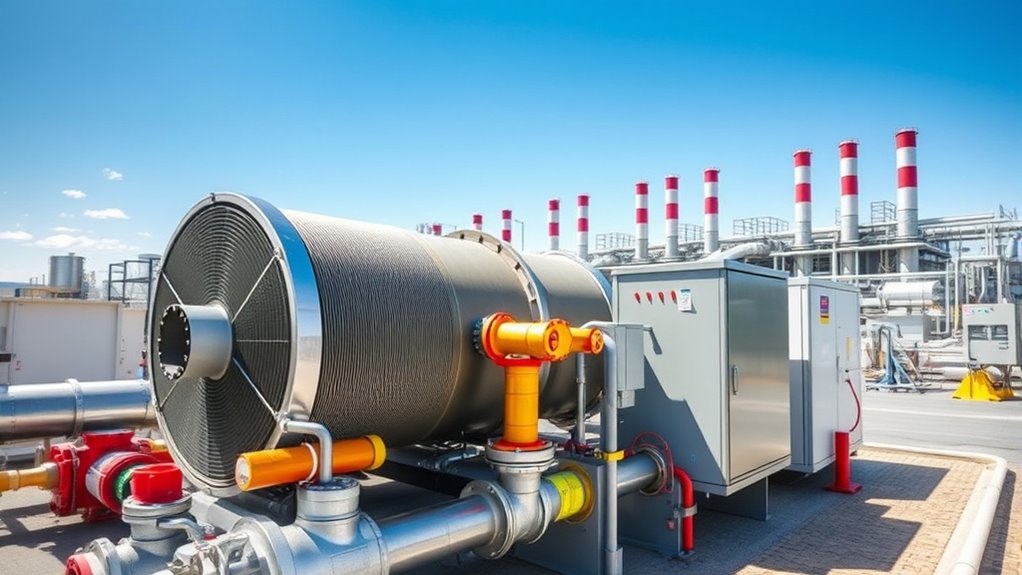Industrial heat pumps boost energy efficiency by recovering waste heat for processes like manufacturing, food, and paper production. They help reduce reliance on fossil fuels, cut emissions, and support sustainability efforts. These systems can operate at high temperatures, enabling applications like process heating, drying, and district energy. Advanced technologies with natural refrigerants and component innovations make them more reliable and eco-friendly. To explore how these solutions transform industries, keep going to learn more.
Key Takeaways
- Heat pumps recover waste heat for process heating, boosting energy efficiency in manufacturing and reducing reliance on fossil fuels.
- They provide high-temperature heat (>150°C) for industries like food processing, pulp, paper, and chemical manufacturing.
- Waste heat recovery systems integrated with heat pumps can increase overall energy utilization by up to 50%.
- Natural refrigerant-based heat pumps help lower greenhouse gas emissions and support industrial decarbonization efforts.
- Heat pumps enable cost-effective hot water, steam, and process heat generation, optimizing operational performance across sectors.
Enhancing Energy Efficiency in Manufacturing Processes
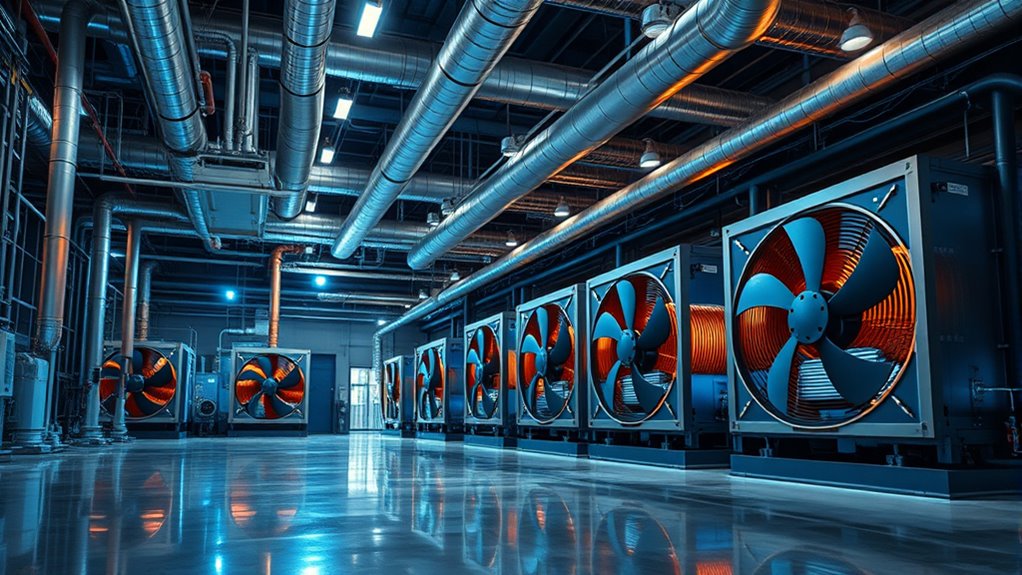
Enhancing energy efficiency in manufacturing processes is essential for reducing costs and minimizing environmental impact. You can achieve this by integrating industrial heat pumps, which notably boost efficiency. These systems use waste heat from production lines to generate additional process heat, cutting energy consumption by up to 33%. Advanced heat pumps operate at high temperatures, exceeding 150°C, making them suitable for demanding manufacturing tasks. With COPs around four, they provide hot water and process heat more cost-effectively than traditional fossil fuel systems. By adopting heat pumps, you optimize energy use, lower reliance on fossil fuels, and support sustainability goals. Understanding the refrigeration cycle involved in heat pump operation can help in optimizing system performance and troubleshooting issues. Additionally, awareness of energy management strategies can further enhance overall system efficiency. Incorporating raw material considerations in system design can also lead to more sustainable manufacturing practices. Moreover, implementing energy-efficient technologies can further reduce operational costs and environmental impact. Ultimately, this approach improves overall energy management while reducing CO2 emissions, aligning your operations with modern efficiency standards.
Waste Heat Recovery and Reuse Strategies
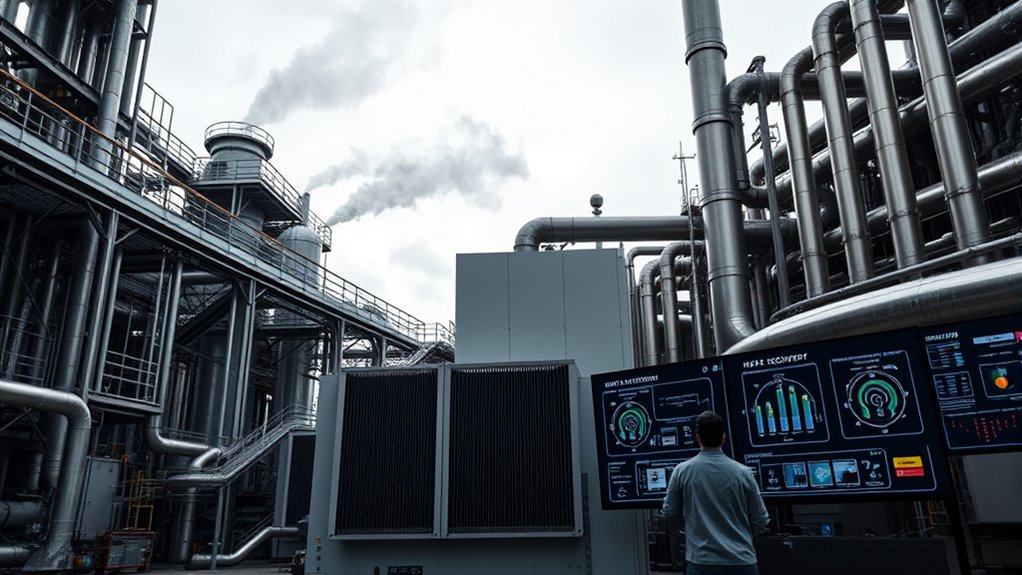
By capturing and reusing waste heat through industrial heat pumps, you can considerably boost your facility’s energy efficiency. Waste heat, often lost at temperatures below 200°C, can be recovered and converted into useful process heat or electricity with these systems. Implementing heat pumps for recovery from exhaust gases, cooling water, or process streams allows you to reuse heat that would otherwise escape into the environment. This strategy can improve your overall energy efficiency by up to 50%, reducing dependence on fossil fuels and lowering emissions. Additionally, heat pump efficiency plays a vital role in maximizing the benefits of waste heat recovery systems. Optimizing heat transfer processes ensures maximum energy recovery and system performance. Incorporating advanced heat pump technologies can further enhance system effectiveness and longevity. Utilizing variable speed drives in heat pump systems can improve operational flexibility and energy savings. Integrating waste heat recovery with heat pumps supports your decarbonization goals and helps stabilize energy supply. By optimizing resource utilization, you turn waste into a valuable asset, making your industrial processes more sustainable and cost-effective.
Industrial Heating for Food and Beverage Production
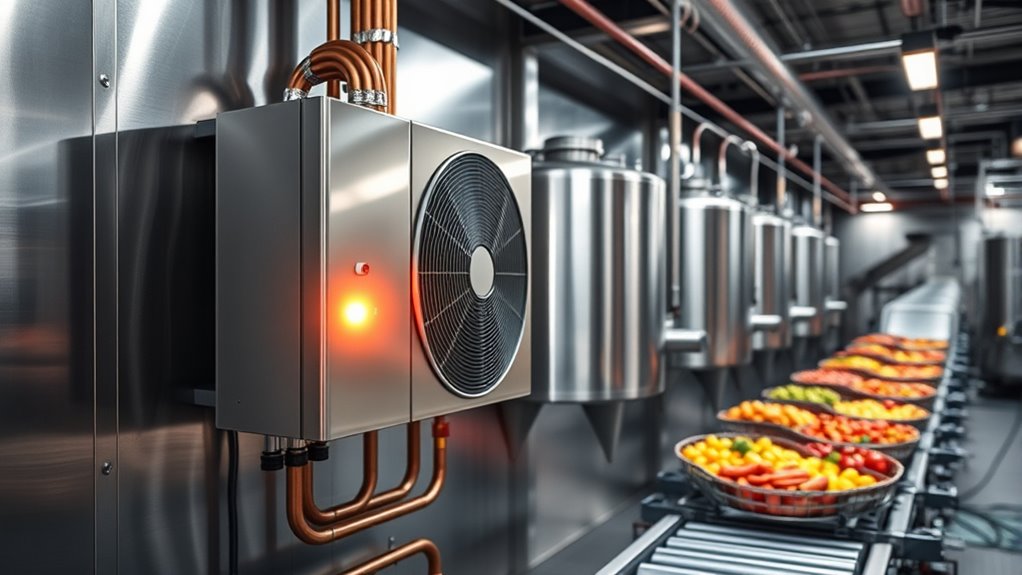
Have you considered how energy-efficient heating can transform your food and beverage production? Heat pumps in industrial applications offer significant benefits, including:
- Reducing energy use by up to 30% for heating process fluids.
- Ensuring precise temperature control in beer brewing, wine fermentation, and concentrate production.
- Supporting dairy processing by concentrating liquids and pasteurization, cutting fossil fuel reliance.
- Providing hot water and steam for packaging and cleaning, boosting sanitation and efficiency.
- Modern heat pumps operate with quiet noise levels, minimizing disruption in busy production environments. Additionally, understanding the GMC tuning process can help optimize machinery performance during these operations.
- Incorporating renewable energy sources can further enhance sustainability and reduce operational costs in industrial heating systems. Implementing AI-powered analytics can optimize system performance and predictive maintenance, leading to increased efficiency. Moreover, integrating customized control systems can tailor heating processes to specific production needs for better results.
Pulp and Paper Industry Applications

Heat pumps are transforming the pulp and paper industry by enabling more efficient process heating, drying, and black liquor concentration. This technology helps you cut energy consumption and boost sustainability. By utilizing waste heat from mills, heat pumps improve overall energy efficiency and support environmental goals. They enable water heating, steam recovery, and product drying, lowering operational costs and emissions. Implementing heat pumps in your industrial process can reduce carbon emissions by up to 40%, aligning with decarbonization objectives. Here’s how they benefit your operation:
| Application | Benefit |
|---|---|
| Black liquor concentration | Energy savings and emission reduction |
| Process drying | Improved efficiency and lower costs |
| Waste heat utilization | Enhanced sustainability and resource use |
Regional knowledge of local laws can influence permitting and compliance strategies, further streamlining the implementation process.
Chemical Process Heating Solutions
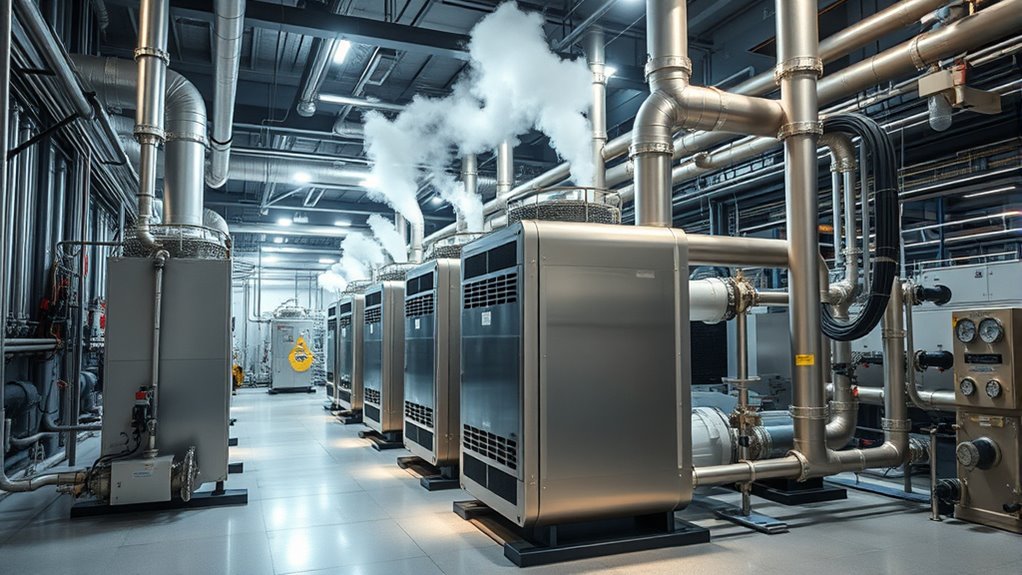
Heat pumps can substantially boost process efficiency in chemical manufacturing by providing reliable, high-temperature heat. They also help cut emissions by replacing fossil fuels and integrating waste heat, making your operations more sustainable. Implementing advanced systems with natural refrigerants further enhances environmental benefits and economic returns. Additionally, selecting vetted products ensures safety and effectiveness in your heat pump applications. Incorporating innovative heat transfer technologies can optimize performance and energy savings across various chemical processes. Incorporating energy-efficient solutions can further improve operational sustainability and cost savings. Moreover, understanding merchant services can facilitate smoother financial transactions and support the adoption of new technologies in your operations. Leveraging thermal management strategies can also enhance overall system efficiency and longevity within your chemical processes.
Process Efficiency Gains
By recovering and repurposing waste heat at lower temperatures, heat pumps considerably enhance chemical process heating efficiency. This approach allows you to optimize your process by upgrading temperatures without extra energy input, leading to significant benefits: 1. Maximize energy savings—up to 30-50%—reducing operational costs. 2. Improve process performance by achieving higher process temperatures efficiently. 3. Support decarbonization efforts by replacing fossil fuel-based boilers with cleaner heat pump solutions. 4. Enhance environmental sustainability through advanced systems with natural refrigerants and modular designs. 5. Incorporating dynamic communication exercises can further strengthen teamwork and operational coordination in process management. Additionally, implementing vertical storage solutions can optimize space utilization within industrial facilities, contributing to overall operational efficiency. Proper storage of heat pump components, including protective enclosures, also plays a crucial role in maintaining system performance and longevity in industrial settings. Utilizing monitoring technologies can help track system performance and quickly identify any issues, ensuring consistent operation and reducing downtime.
Environmental Benefits Enhancement
Implementing heat pumps with natural refrigerants can substantially reduce greenhouse gas emissions in chemical process heating, helping your operations become more sustainable. By replacing fossil fuel-based systems, you support heat decarbonization and cut your energy use, lowering your carbon footprint. Heat pumps enable effective recovery and reuse of waste heat, which further enhances environmental benefits and decreases overall emissions. This recovery process can eliminate millions of tons of CO2 annually across the chemical sector. Using environmentally friendly refrigerants like propane and isobutane not only boosts energy efficiency but also helps your facility comply with F-gas regulations. Additionally, integrating heat pumps into your operations aligns with Private Placement Equity Markets investment strategies that prioritize sustainable and innovative solutions. Ultimately, adopting these solutions promotes sustainability, reduces environmental impact, and aligns your operations with global decarbonization efforts. Moreover, advancements in refrigerant technology continue to improve the performance and environmental benefits of heat pump systems.
Integration With Waste Heat
Integrating heat pumps with waste heat sources allows chemical manufacturers to efficiently convert low-grade thermal energy into useful process heat. By leveraging heat pump technology, you can recover waste heat from processes like effluent cooling or residual exothermic reactions. This integration offers several benefits:
- Boosts process temperatures up to 150°C or higher, improving energy efficiency.
- Reduces reliance on fossil fuels, lowering operational costs.
- Recovers heat from cooling water and process streams, minimizing waste heat discharge.
- Supports decarbonization by transforming otherwise lost thermal energy into valuable process heat.
Proper system design involves matching waste heat source temperatures with the heat pump’s operational range and using heat exchangers to optimize heat transfer. This approach enhances industrial efficiency and environmental sustainability.
District Heating and Urban Infrastructure Integration

Urban infrastructure is increasingly leveraging heat pumps to create more sustainable district heating systems. By integrating large industrial heat pumps, you can efficiently supply temperatures between 60°C and 135°C, utilizing waste heat from industrial processes, data centers, and sewage systems. This approach repurposes waste heat, making district heating more eco-friendly and reducing reliance on fossil fuels. Using heat pumps in urban infrastructure supports decarbonization efforts by replacing traditional fossil fuel boilers with renewable, electrically powered solutions. Advances in technology and decreasing costs are enabling larger systems that serve entire communities, especially in Nordic countries and the EU, where up to 20% of industrial heat needs could be met through heat pumps by 2030. Collaboration among OEMs, municipalities, and utilities is essential for optimizing these integrated, reliable heat networks.
Cooling Opportunities in Industrial Settings
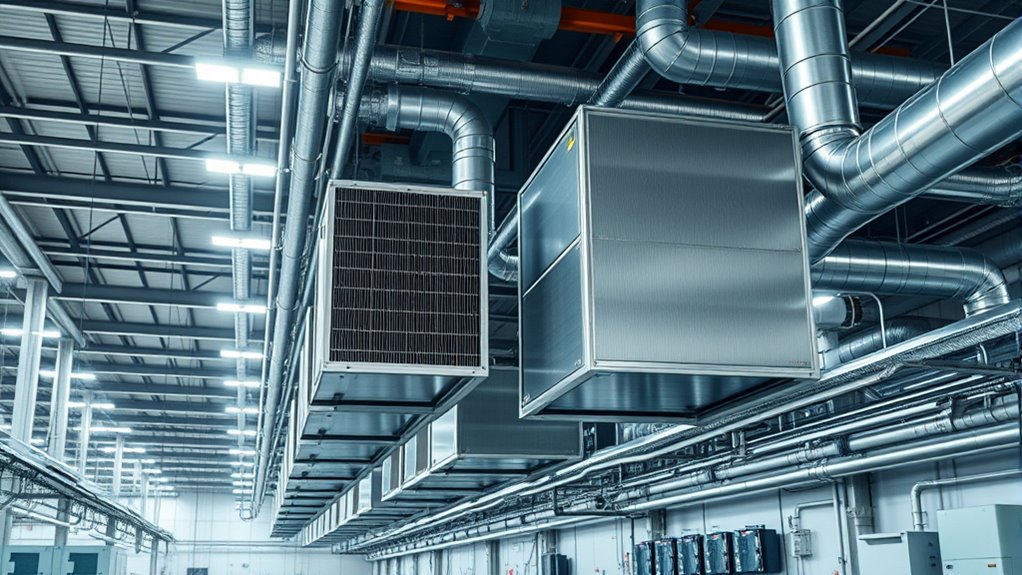
Did you know that heat pumps can be used not only for heating but also to provide efficient cooling in industrial settings? This approach maximizes resource use and reduces energy costs. Here’s how you can benefit:
- Utilize waste heat for cooling, turning a byproduct into a valuable resource.
- Incorporate renewable energy sources to power heat pumps, lowering carbon footprints.
- Recover heat during low-demand periods, storing or repurposing it for other processes.
- Use natural refrigerants like propane or isobutane to achieve high thermodynamic performance while meeting environmental standards.
High-Temperature Heat Pump Technologies

High-temperature heat pumps face material compatibility challenges that can affect durability and performance at elevated temperatures. Improving efficiency at these levels relies on technological innovations in compressors, heat exchangers, and control systems. Ongoing research aims to address these issues, making high-temperature heat pumps more reliable and suitable for demanding industrial processes.
Material Compatibility Challenges
Have you ever wondered how heat pumps operate reliably at temperatures above 150°C? High-temperature heat pumps face material compatibility challenges that are vital for their performance and longevity. To withstand extreme thermal stresses and chemical interactions, you need:
- Materials with excellent corrosion resistance to combat oxidation and chemical reactions.
- Alloys that balance thermal conductivity, mechanical strength, and durability.
- Precise design to accommodate thermal expansion and contraction, preventing leaks.
- Compatibility with high-temperature refrigerants and lubricants that may react with certain materials.
Selecting the right materials is indispensable to prevent degradation, maintain efficiency, and extend system lifespan. Addressing these material compatibility issues ensures high-temperature heat pumps operate safely and reliably in demanding industrial environments.
Efficiency at Elevated Temperatures
Advancements in heat pump technology now enable systems to deliver process heat at temperatures above 150°C, with some reaching up to 280°C for industrial needs. High-temperature heat pumps achieve higher thermal output efficiencies through innovations like cascade compression and multi-stage processes, which optimize thermodynamic performance at elevated temperatures. These systems are designed to overcome material constraints and reduce thermodynamic losses that typically affect efficiency at higher heat levels. By carefully selecting advanced materials and refining component design, manufacturers improve performance and reliability. Such improvements are essential for industries like chemicals, steel, and cement, where process heat beyond traditional limits is crucial. These developments support decarbonization efforts, making high-temperature heat pumps a promising solution for sustainable industrial heat supply.
Technological Innovation Pathways
Innovations in compressor design, such as multi-stage and magnetic drive technologies, are critical for enabling high-temperature heat pumps to operate efficiently above 200°C. These advancements allow for higher pressure ratios necessary for industrial processes. To support high-temperature applications, focus on:
- Developing advanced heat exchangers like plate-and-shell and microchannel types for better heat transfer and system compactness.
- Using environmentally friendly refrigerants with high critical points, such as natural refrigerants like propane and isobutane.
- Integrating waste heat recovery and renewable energy sources to boost system sustainability.
- Enhancing system materials and sealing techniques to withstand elevated temperatures and pressures.
These innovations are paving pathways toward more efficient, eco-friendly high-temperature heat pumps, expanding their industrial applications.
Component Innovations for Industrial Heat Pumps
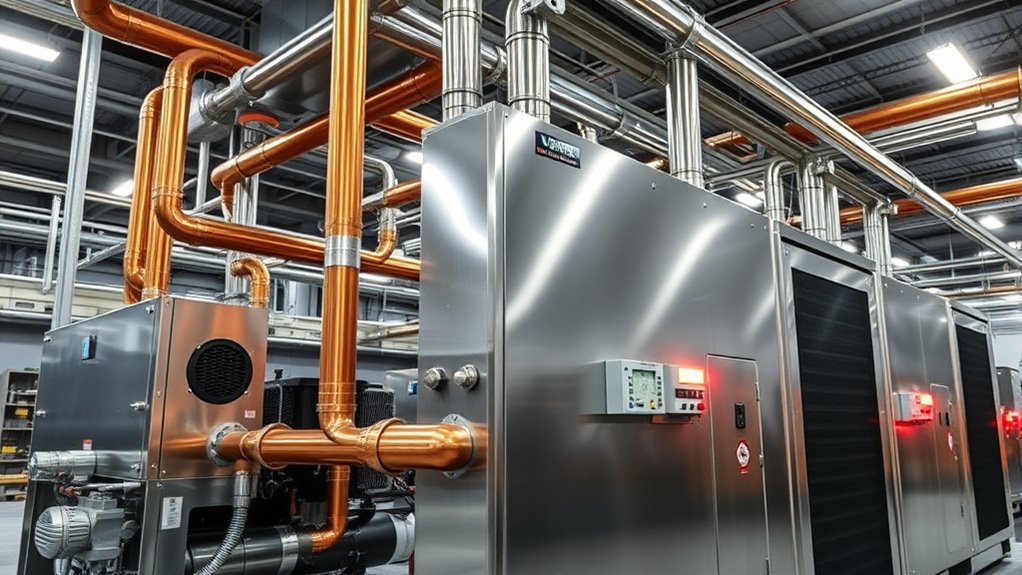
Component innovations play a pivotal role in enhancing the efficiency and cost-effectiveness of industrial heat pumps. High-efficiency compressors are essential, as their design influences 20-35% of hardware costs and improves refrigerant flow and system performance. Advanced heat exchangers, especially plate-and-shell types, boost heat transfer efficiency and enable more compact, affordable designs. Developing modular components allows for scalable solutions tailored to diverse industrial needs while reducing manufacturing costs. Additionally, integrating natural refrigerants like propane and isobutane enhances environmental performance and thermodynamic efficiency, though safety considerations must be addressed. These innovations collectively improve system reliability, reduce costs, and support sustainable operation, making industrial heat pumps more adaptable and effective for various applications.
Collaborating Across Sectors for Sustainable Heat Solutions

To maximize the benefits of recent component innovations, collaboration across different sectors becomes essential. Industrial heat pumps, when combined through strategic partnerships, enhance energy efficiency and accelerate decarbonization efforts. Collaboration allows you to:
- Share expertise and best practices, speeding up adoption and optimizing system design.
- Develop large-scale, reliable, and cost-effective industrial heat pump systems tailored to diverse needs.
- Integrate multiple heat sources such as waste heat, solar, and incineration, improving energy stability.
- Foster innovation by addressing sector-specific challenges and regulatory requirements.
Building this collaborative ecosystem enables you to scale deployment, reduce costs, and achieve sustainable heat solutions. Ultimately, cross-sector cooperation is key to accessing the full potential of industrial heat pumps for a greener future.
Frequently Asked Questions
What Are the Industrial Applications of Heat Pumps?
You might wonder how heat pumps are used in industries. They recover and upgrade waste heat for various processes, helping you save energy and cut emissions. Whether it’s heating water, drying materials, or generating steam, heat pumps work efficiently at high capacities. They support decarbonization efforts by replacing fossil fuel boilers, making your operations greener and more sustainable. Plus, they adapt to different temperature needs across sectors like food, chemicals, and metals.
What Are the Industrial Applications of Heat?
You’re asking about how heat is used in industries, and you’ll find it’s essential for many processes. You might heat water, dry materials, or preheat equipment, depending on the industry’s needs. You’ll see heat used in food production, chemical processing, and metal manufacturing. By efficiently managing heat, you save energy, reduce costs, and improve sustainability across various sectors.
What Are the Various Applications of Heat Transfer in Industrial Process?
You’re asking about how heat transfer is used in industrial processes. You’ll find it playing a crucial role in heating, cooling, and maintaining specific temperatures to guarantee product quality and process efficiency. Whether recovering waste heat, heating chemicals, drying materials, or sterilizing, heat transfer techniques help optimize energy use, cut costs, and reduce emissions. You see it as an fundamental part of modern industry, supporting sustainability and operational effectiveness.
What Is the Trend in the Heat Pump Industry?
You might think the heat pump industry is just sticking to small-scale, simple jobs, but you’d be wrong. The industry is booming, with over 15% growth projected annually until 2030. Bigger, integrated systems are replacing tiny ones, driven by tech innovations and policy incentives. High-temperature models now reach up to 280°C, and sectors like chemicals and food are leading the charge toward decarbonization, making heat pumps more essential than ever.
Conclusion
By adopting advanced heat pump technologies, you can substantially boost your industrial energy efficiency and reduce emissions. Did you know that waste heat recovery alone can cut energy costs by up to 30%? Embracing these innovative solutions not only saves money but also contributes to a more sustainable future. Take action now—integrate heat pumps into your processes and make a meaningful impact on your industry’s environmental footprint.
